You walk into a craft store, WalMart, or preferrably your local yarn shop (LYS), or you browse one of the many online pushers purveyors of fine string. You want to start your first weaving project, but the choices are overwhelming – wool, acrylic, cotton, linen, silk, smooth, fuzzy, fat thin… HELP! If you are in your LYS someone will most likely come to your rescue, but anywhere else you are on your own. Even if you do have knowledgeable assistance, it’s nice to know a little bit about string, especially what qualities make it more likely that your first weaving project will be successful.
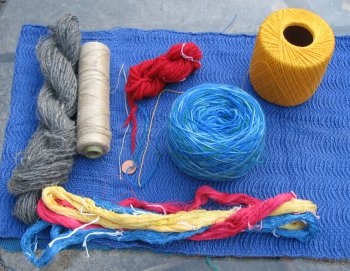
Clockwise, from the left: a skein of handspun wool weaving yarn, a cone of 20/2 linen, a small skein of red worsted-weight wool knitting yarn, yellow crochet cotton, a ball of wool sock yarn, and several skeins of dyed 60/2 silk.
Some of these will work beautifully for weaving, some of them will make swear off weaving forever if you use them for your first project. But how do you know? And what do all those numbers and funny words mean?
Let’s start with the very basics. Yarn is made up of spun fibers The fibers can be animal (wool, silk), vegetable (linen, cotton), mineral (asbestos), or synthetic (nylon, acrylic). Except for silk, which can be reeled off the cocoon in extraordinarily long lengths, all of these materials are shorter than the lengths you need for weaving. If you just take a handful of fibers, like the cotton from the top of a new aspirin bottle, and tug on two ends, the fibers will just pull apart. Not too useful. Adding some twist locks everything together, and turns a mass of fibers into a yarn that will stand up to some tugging, maybe even a lot of tugging. There are all sorts of ways to put spin in, from twisting it between your fingers to a drop spindle to a spinning wheel, but for now I’ll just assume you are going to buy yarn for this project.
Some more basics, first, though. You can spin yarn in two different directions – think clockwise and counterclockwise – but for convenience those directions are called S and Z after the directions of the middle stroke of the letter.

(Yes, that’s actually a tablet weaving illustration from elsewhere on this site, but the principle is the same.) The great thing about S and Z is that it’s the same whether you’re looking at the yarn from the front or back or upside-down – it’s always S or always Z.
If you take some fibers and add twist, you’ve made a singles yarn. Singles tend to be less well-behaved than you might like for weaving or knitting, so two or more singles are usually plied by twisting them together in the opposite direction from which they were originally spun. S-spun singles are plied in a Z-direction, and Z-spun singles are plied in an S-direction. (Okay, you don’t really need to know this right now, but it’s part of a complete introduction to string and I like it.)
The amount of twist put into the fiber and the way it was done determines whether your yarn is light and fluffy or smooth and dense, and thus how well it will work for any particular project. For most weaving projects, especially as a novice, you want smooth and dense yarn that will stand up to some tension and some abrasion. Not thick, necessarily, but tightly-spun and plied. Knitting yarn is not generally good weaving yarn, since it doesn’t have to experience much tension or friction during the knitting process. We often want knitted items to be soft and squishy, or lofty, like comfy hats or mittens, and the yarn can be fuzzy. Neither of those are good traits for weaving yarn to have.
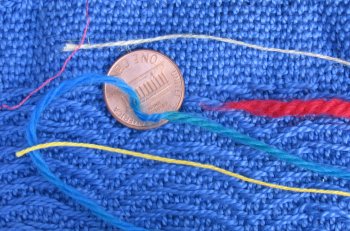
These are the same yarns as in the previous photo, with a US penny for scale. See how loosely-plied the blue yarn that crosses the penny is? It will make great socks, but be lousy for weaving. Same for the thicker red yarn. It’s a bit more twisted, but very lofty and not so good for weaving. If you picked up a ball of either and squeezed it, it would be squishy and soft. If you picked up a ball of any of the other three yarns shown there, it would be much firmer. That’s a good clue as to how the yarn will work for weaving.
Other things to look at while you stand in the store looking at the selection of yarn are surface texture and strength. If it’s fuzzy, don’t buy it. Look for a yarn with a smooth surface. No eyelash or other novelty stuff. Later, once you know what you are doing, then you can experiment with anything, but for your first weaving project they will make you insane. Don’t try it on yarn you don’t own, but if you can give a good tug on a yarn and it breaks, you probably also don’t want it (for now). Your yarn needs to be able to resist some tension and some abrasion and not stick to itself, which is why strength and surface finish are important.
For complete beginners, I usually recommend crochet cotton like the yellow ball. It is readily available, even at WalMart (not that I advocate shopping there), comes in a range of colors, and is reasonably attractive and inexpensive. Silk is fantastic to weave with, but it is expensive and harder to find, and is often too fine for beginners to be comfortable working with it. Wool can be good, but many wools are not abrasion resistant or stick to each other too readily. Save the wool for a later project, and look for a weaving yarn rather than a knitting yarn. I enjoy weaving with linen, but it can be a frustrating experience. Linen is sensitive to humidity and can shrink or slacken, causing all sorts of problems. For now, go with a strong, smooth cotton. Look back at the close-up photo – see how smooth and tight the yellow cotton is?
As a beginner, you should really just pick a size that looks comfortable to work with. If you have a loom already, you also need to make sure your chosen yarn will fit through any heddles. (If you don’t have a loom, no worries! The whole point of this series is to get you weaving as painlessly as possible.) The most common size specification for weaving yarns has two numbers separated by a slash, like the 20/2 linen I described above. The smaller number is the number of plies, so that linen is a two-ply yarn. The larger number has to do with the length of yarn per weight, although the specifics vary by fiber. (Can’t be simple and straightforward, can it?) That photo and the closeup show 20/2 linen, and I also have some 40/2 linen that is exactly half the size. The 8/2 cotton I have is a little bit larger than the 10/2, but both are two-ply. The 60/2 silk is much smaller – you can barely see it in the photo. Sometimes the numbers are written the other way around, like 2/60. Just remember that the smaller number is almost always plies, and the larger number is some measure of “yarn density”, the length:weight ratio. Here’s a simple explanation and a detailed explanation.
But wait… knitting yarns use a different system altogether, with the description in words instead of numbers: worsted, bulky, fingering, and so on. Even worse, “worsted” means something entirely different to spinners. What about that random yarn in my stash that I lost the ball band for? It looks like good weaving yarn, but I need to know how big it is? And my handspun, too. Do I have to weigh it? Isn’t there some simple system? This is too complicated!
Here’s a easy solution that you can use with any yarn from anywhere, even if you spun it yourself, and that you can use for all your string planning: wraps per inch (wpi). Yes, I know: we’re pretty much the only ones who use that measurement anymore. For the rest of the world, I give you: wraps per 2.5 cm. Or more usefully, it’s a good idea to do two inches of wrapping, which is 5 cm, so that’s fairly convenient for everyone.
Take a piece of yarn, and a ruler, and start wrapping.
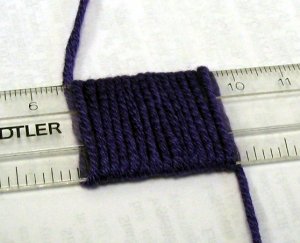
Be kind of relaxed, but not sloppy – don’t pull too tight. Slide the wraps together, but don’t squash the yarn. I know this is kind of vague, but it makes sense when you try it. (And if the yarn really wants to squash together, you might want to find something else to try weaving with!) Count how many wraps complete cover 2 inches on the ruler, and divide that in half to get wraps per inch. If you record that number in your project notes, you will be able to decide later if other yarn is the same size so that you can get similar results, no matter what fiber it is or where it came from. This yarn is 14 wpi. I can use that to look up the approximate number of yards per pound, the suggested knitting gauge, and to figure out how much yarn I need to weave a certain length of cloth.
One more “string-thing”, before I stop for the day. Yarn comes in a variety of yarn-packages, usually called put-ups. These are the main three: cone, skein and ball.
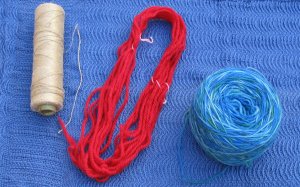
Cones are frequently cone-shaped and much bigger. Knitting yarn and handspun are usually in skeins because those don’t put any tension on the yarn. Skeins can only be used for smaller quantities, so weaving yarns are usually on cones (loom weavers need a lot of yarn!) and those yarns don’t mind the tension as much. Skeins are not good for working from, though, so you need to wind them into a ball or onto a core before using. I’ll get to that later, since pictures would be helpful.
I think that covers the basics. There are lots of other things that I could talk about, but this takes care of everything you need to know before you start weaving. So go pick out some yarn already! Next time we’ll get it ready to go and I’ll explain the basics of weaving.
If you are going to actually play along, when you go buy yarn / rummage in your stash, pick out a couple of colors that you like. One ball of each is waaay more than you’ll need, so leftovers from other projects will be fine. Also get some “utility string”, something cheap and sturdy that you can’t easily break with a good yank, and with a smooth surface. Butcher’s twine, from back when butchers did that, would be fine, or anything similar.
And finally:

If you spin your own, you can get exactly what you want. If you practice enough, that is. I’m not there yet! The brown is mittens-to-be, and the other is one of the batts of roving that I dyed, still looking for a project.
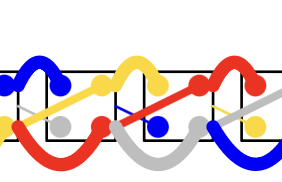
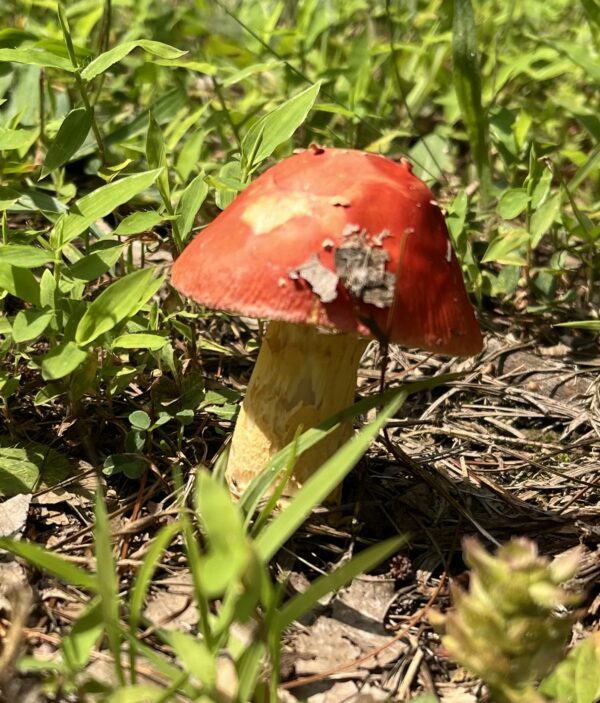
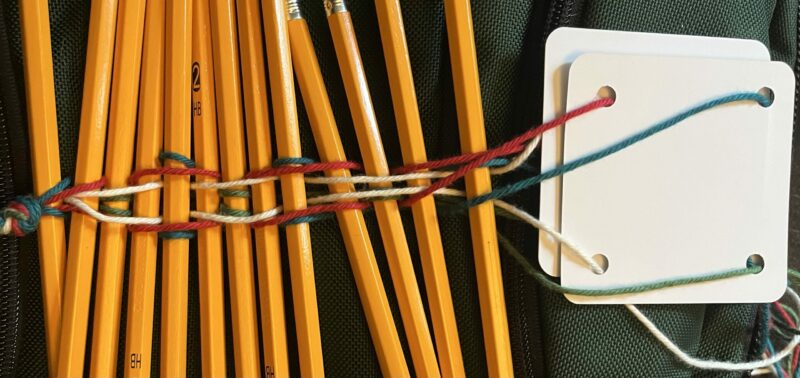
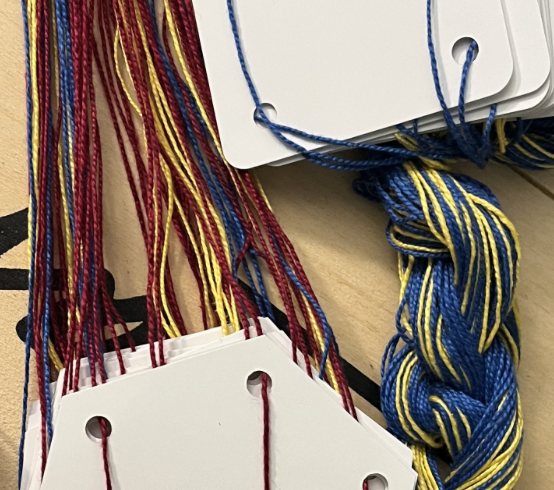
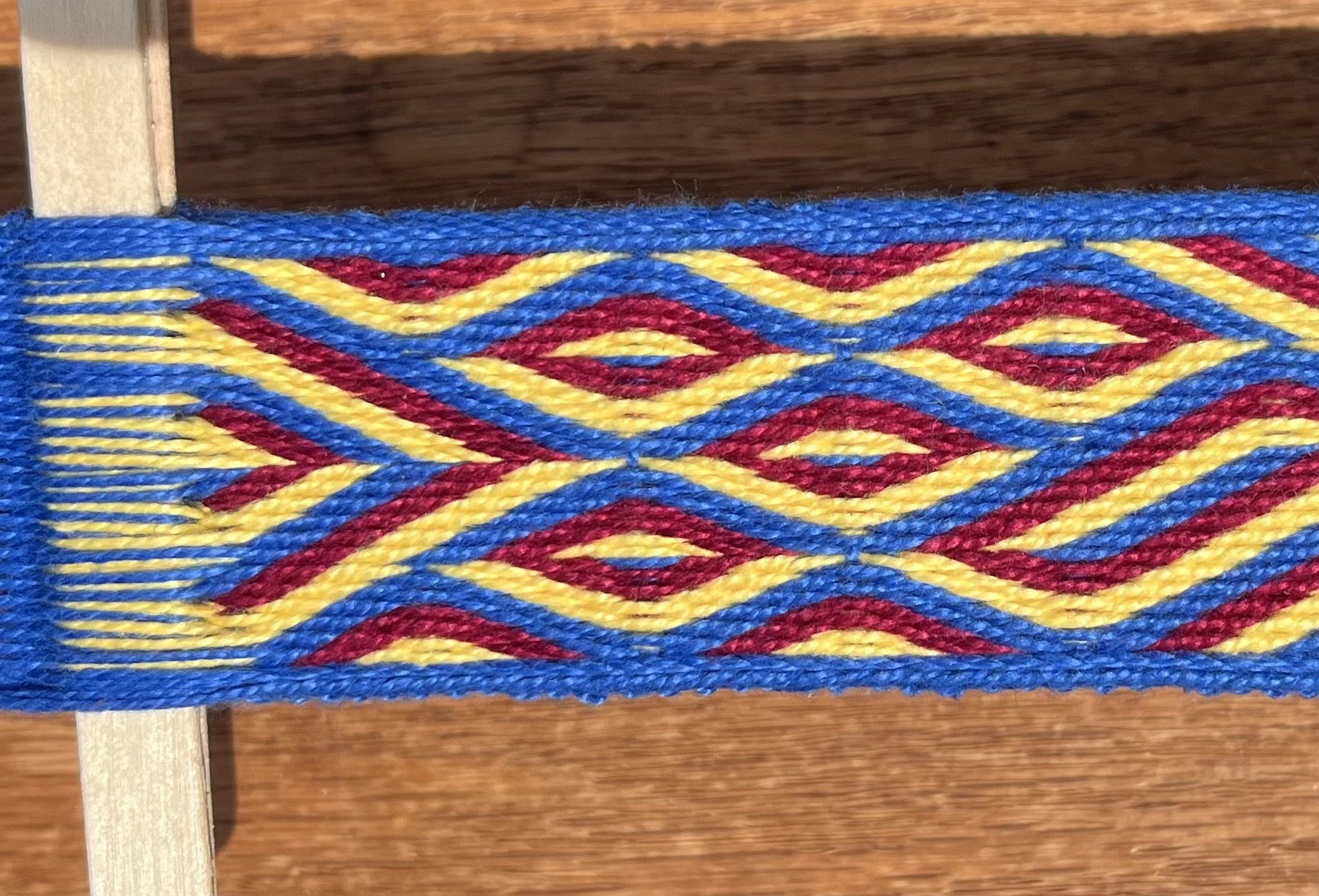
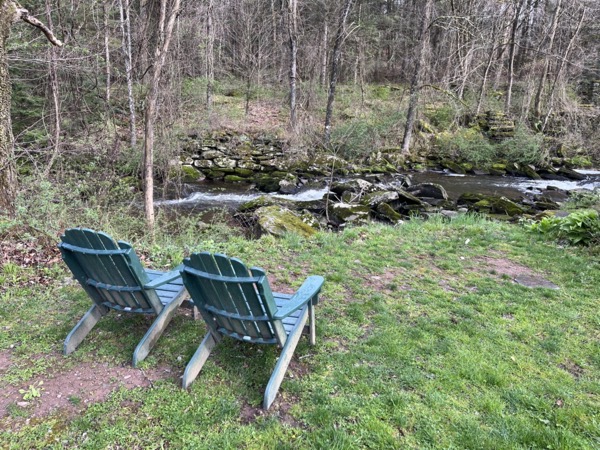
One response to “Start with the string”
SWEET! Very thorough and informative. I just discovered you today, which is perfect, since I just checked out some books (particularly inkle, card, and general band-weaving books, tablet stuff. A couple of tapestry ones too.
I’ve been looking into this for the last couple of weeks. Looking forward to the next part(s) as they come! Thanks!